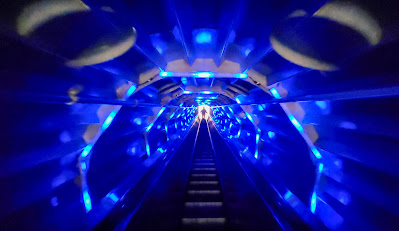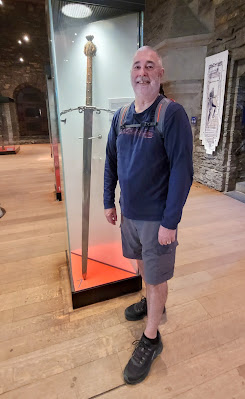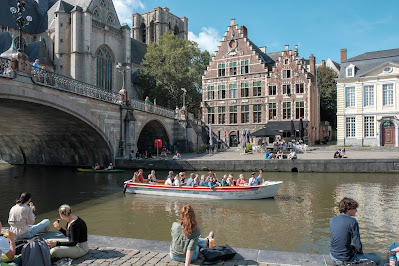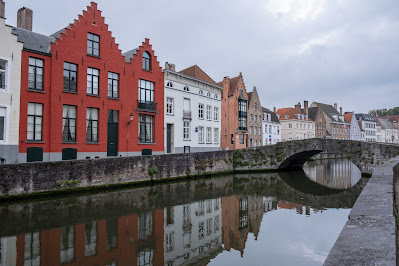To reach Belgium we would travel by train, including an overnight stop to explore the port city of Hamburg before continuing on to Brussels.
It was a funny train trip to Hamburg, because we were seated in a compartment with a couple from Amsterdam and a couple from Sweden. It took a little while but with us all being constrained in a box for 4.5hrs, everyone relaxed and were soon sharing the culture and views of each of our countries. They all seemed a little more interested in our strange animals.
With only a few hours to use after reaching Hamburg we explored parts of this city of 1.9M people and one of the largest trans-shipment ports in the world.
It was a very pleasant surprise in Hamburg, with its interesting architecture, cathedral, massive lake, tidal rivers, historic Speicherstadt (warehouse district) near the port and old bridges.
The Speicherstadt buildings were built on timber-pile foundations between 1883 and 1927 as a customs free zone and are now a UNESCO heritage area.
 |
| Part of the dining area next to a river in Hamburg central |
 |
| The Cathedral |
 |
| Some innovative architecture in Hamburg |
 |
| The historic Speicherstadt area of Hamburg |
Next morning it was another train trip heading to Brussels Belgium, with a train change in Cologne. Normally the trains are always on time but alas, the train departing Cologne ended up being 1hr late.
There were consequences with the delay however. We were due to get off at one of multiple stations in Brussels… Gare du Midi but the train stopped earlier at Gare Nord where lots of people were trying to get on but not many people including us getting off.
Then we heard, “the trains not continuing” being yelled by one of the passengers due to the trains late arrival. So we had to get off but had no idea of how to get to du Midi, let alone a ticket. We asked another passenger who said, get on that train, we did but it also stopped somewhere else so we tried another, got scolded by a guard but we reached the right station.
Our hotel was not to far from the station but was in a less salubrious part of the city, including massive roadworks happening but the hotel itself was very nice, oh well. I had been here many years ago on a work trip and didn’t like the city at all but my attitude changed dramatically, as hopefully you will understand with what follows.
Our plan was to be in Belgium as a whole for 8 nights, split between Brussels, Bruges and Ghent, so will deal with them in that order.
 |
| Brussels to Bruges & Ghent is an easy train trip(s) |
Our initial view of Brussels changed very quickly once we caught a train into the centre of town and began to explore. The train system is excellent and you can pay using a credit card at that gate and it stops charging when you reach 7.5 Euro in a day.
We chose to first visit the Atomium by local train as it opened, because it was out of town and the weather was unseasonably hot at 30+c. The Atomium was built in 1958 for an Expo being held and its shapes says it all. Inside however are elevators, stairs and escalators so we took the elevator to the top viewing area, enjoyed the views and worked our way down.
 |
| The Atomium during the day |
 |
| The Atomium arms |
 |
| Going down inside one of the arms |
As we moved down through the ‘arms’ we were treated to various displays about its construction of light and music shows, including when going down an arm on an escalator… very cool indeed.
 |
| Innovative music and light shows were throughout the Atomium |
Back in the city using an app called GPSmyCity, which we now really love, for visiting the sights of a city, it guided us to the various main attractions you will see in the pictures below.
There are some very notable historical locations, for example the Grand Place or Square and UNESCO listed. It is very large and has many historical buildings around its border and dominated by the gothic town hall and Kings House. The square was also where Protestant martyrs were burnt alive and counts beheaded.
Other ‘must’ see locations in the city centre include, the Royal Galleries of Saint Hubert, Manneken Pis - a little male statue on a fountain whose clothes are changed each day and Jeanneke Pis… the female version but without clothes. We passed the Manneken Pis a few times during our walks and every time it was crowded with tourists.
 |
| Royal Galleries of St Hubert |
 |
| Jeanneke Pis |
 |
| Manneken Pis |
Belgium is also renowned for 4 gastronomic treats - chocolates which we did not particularly indulge in, beer of which there are hundreds of varieties and unique glasses for each brand of beer, waffles with a big range of toppings and chips/frittes/french fries.
 |
| Chocolates, lots of chocolates shops everywhere |
 |
| The waffles were delicious |
 |
| A huge selection of beers with special glasses |
 |
| Famous beer 'hall' in Brussels |
The Belgiums claim to have invented chips when they were short in supply of small fish they deep fried and ate whole. So during the fish shortage, they cut potatoes to a similar size, deep fried them such that they were crispy on the outside and softer in the middle to replicate the small fish.
During WWII, American soldiers in Belgium tasted these for the first time in the French part of Belgium and called them french fries, taking the name and the method back to the USA… or so the story goes.
 |
| Rob's happy with her choice in the home of fries |
Back in the seedier side of town we went searching for the cartoon area and the large cartoon drawings on the walls of buildings down narrow little streets.
 |
| The cartoons on the wall are very well done |
 |
| The Atomium at night |
The train system in Belgium is excellent like most of Europe, so it was an easy ride of around 1hr to reach Bruges, another city we had been keen to visit for years. It was a weekend and it was hot, so there were giant queues trying to catch the trains heading both to Bruges and further on to the beaches.
We stayed in a 16-17th century house now being used as a B&B known now as the Huis ’T Schaep or House of the Sheep. Throughout the building, including our room, it was very ornate and we were very well looked after by the hosts.
The old part of Bruges is for walking with its old city wall, multiple canals throughout, historical buildings and boat tours along the canals.
 |
| Bruges is a great walking city and we certainly did a LOT of walking |
So where to start because we really enjoyed exploring this old town which was not damaged by WWII because it’s located in the north of Belgium and at the time it was a poor town. Since then it’s flourished mainly due to being ‘found’ by tourists.
Everywhere we walked there were lovely little alleys to find, or old buildings and interesting architecture to admire but some of the main locations for us included Grote Markt (Market Square) used as a market since 958AD and in which is located the Belfy, circa 1240, which we climbed up 366 steep spiral steps, listening to its carillon of 44 bells on the way, before enjoying the views out over the city.
 |
| The Belfry in Grote Markt |
 |
| The carillon bells in the Belfry |
 |
| View from the Belfry |
There are just sooo many notable buildings of historical significance before turning to the canals, especially at night where over 2 nights we enjoyed the reflections on the water as buildings were lit up. There are of course LOTS of churches throughout the city and one, The Basilica of the Holy Blood, built from 1134 and housing an ancient relic, supposedly of a piece of cloth used to wipe blood off Jesus. It has now become a pilgrimage site.
 |
| Just go for a walk and you will find something wonderful to admire |
 |
| Town Hall Bruges |
 |
| The canals provide lots of scenery |
There were 2 other notable buildings in Bruges which Rob had researched and was extremely keen to visit, the first being ye’Old Chocolate House’. We found it and Rob was quick to make her chocolate selection of salted caramel, and I made mine and we waited. Shortly in front of us sat a largish bowl of hot milk and a plates with our chocolate ‘ball’ selections on them. Our task was to place the chocolate into the bowl and slowly stir until it was all melted, pick the bowl up and drink the now hot flavoured milk chocolate… very nice.
 |
| Now this is a hot chocolate! |
Those who know Rob well are aware she is a little… no, VERY partial to potatoes and the name of the next establishment we had to locate was ‘The Potato Bar’ which didn’t take too long and she was soon a very happy lassie!
 |
| Rob enjoying her favourite food |
On one section of the walls are old windmills built in 1888 and moved to Bruges in 1912 and if walking another section of the town following one of the canals towards the ocean side, we passed or crossed bridges enabling the locals to move within the old town.
 |
| Canals mean bridges, lots of bridges |
During the day with hordes of tourists coming from other cities for day tours, Bruges was very very busy, especially now post covid, but as the sun started to recede below the horizon, Bruges calmed down and became very peaceful indeed.
There is even a lake called Minnewater or Lovers Lake, regarded as the most romantic location in Bruges due to the legend of Minnie who search for her lover over over a long distance only to die in his arms at the lake when she had found him.
 |
| Minnewater to the right on Lovers Lake |
 |
| We also enjoyed the architecture in Bruges |
 |
| Just stunning at night |
We had sincerely enjoyed our 3 nights in Bruges as we walked back through some narrow lanes finding our way back to the railway station for our 30 min trip to the next city of Ghent.
Ghent is very different to Bruges in that its a lot bigger, is a University town so filled with more younger people and the energy they bring, is a historical port city on 2 rivers, has canals and is known to be a city of public squares and marketplaces. Additionally, its tram system is very easy to use and a great way to get around the city.
 |
| A good tram systems and walking got us around Ghent |
Gravensteen Castle built in 1180 has an imposing presence in the middle of town and was our first destination. With audio unit in hand and one of the funnier audio tours we have experienced, it took us over 2 hrs to work our way through and up into the castle.
The person who built the castle wanted one the same as he had seen during his presence at the 2nd Crusade but had, since his demise, been used for a range of things including a court and prison/torture centre.
 |
| Gravensteen Castle is located in the centre of town and very impressive |
 |
| That's not a sword... this is a sword |
 |
| Original armour from the crusades |
 |
| Celebrating torture... maybe or maybe not |
Many of the attractions in Ghent are located around the central river area with 3 dominant large towers and structures dominating the area, St Michael’s Bridge is the link between everything and the Korenmarkt or Wheat Market is the dominating square where people meet and chat, especially the university students.
 |
| Korenmarkt near the river |
 |
| Ghent is a University city and young people abound |
 |
| Views from and along St Michael's Bridge in Ghent |
Now here is a name for you, Sint-Niklaaskerkor or St. Nicholas Church is but one of the celebrated 3 towers of Ghent in the central area, and building it commenced during the 12th century and it had a turbulent history, including being used as a horse stable during the French revolution.
 |
| 'The church' |
Ghent has a magnificent Stadius or Town Hall, and is in fact a quadrangular group of buildings built during the 16th century and is adorned with 19 statues of the Counts of Flanders in niches within the structure.
 |
| The Town Hall |
Ghent was where we learned that trolls were actually a ‘thing’ when we discovered and enjoyed a drink in the Troll Pub with various smaller trolls scattered within the building. We have since learned there is also a troll in Mandurah, Western Australia.
 |
| Who would have thought... a troll pub! |
Belgium overall with the 3 cities we visited had been a very interesting, historical and beautiful country to explore and with the 3 languages of German, French and Dutch (Flemish) used in different areas, makes it even more intriguing.
But it was time to catch yet another train to our next destination
CLICK HERE for a few more Ghent photos
So until the next railway station…. aufwiedsen and go well!


















Glad you got your potato fix Rob. Looks like you’re having a great time. More interesting places to explore and to add to the count. Safe travels Sue and Colin 😎
ReplyDelete